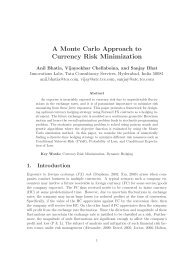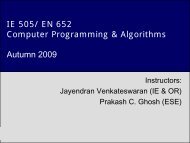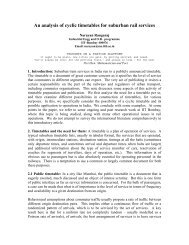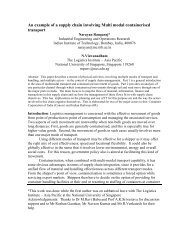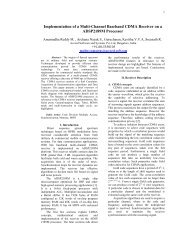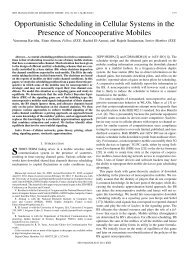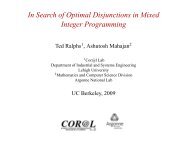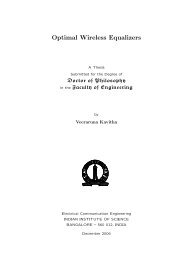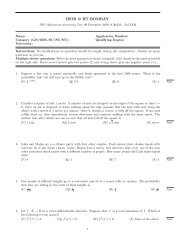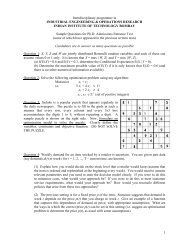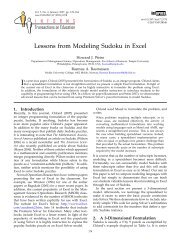Presolving Mixed-Integer Linear Programs - COR@L
Presolving Mixed-Integer Linear Programs - COR@L
Presolving Mixed-Integer Linear Programs - COR@L
You also want an ePaper? Increase the reach of your titles
YUMPU automatically turns print PDFs into web optimized ePapers that Google loves.
<strong>Presolving</strong><strong>Mixed</strong><strong>Integer</strong> <strong>Linear</strong><strong>Programs</strong> 3<br />
is infeasible because of this constraint. If we have a singleton row, namely, a ik ≠ 0,a ij = 0 ∀j ≠<br />
k,j ∈ {1,2,...,n}, for some i ∈ {1,2,...,m} and some k ∈ {1,2,...,n}, then the ith constraint<br />
can be removed,and the bounds ofvariablex k can be tightenedif necessary.<br />
Removing variables If we have a ij = 0 ∀i ∈ {1,2,...,m} for some j ∈ {1,2,...,n}, then we<br />
can fix the variable x j to l j if c j ≥ 0 or to u j if c j < 0. After fixing the variable, we may have<br />
an additional constant term in the objective function. If we have a singleton column x j , and if<br />
j ∉ I, a ij > 0, l j = −∞, u j = ∞, c j ≤ 0 then we can drop the constraint i and substitute<br />
x j = b i− ∑ k:k≠j a ikx k<br />
a ij<br />
intheobjectivefunction. Afterthesubstitution,wehaveonelessvariableand<br />
one less constraint. The number of nonzeros in A is also reduced. The number of nonzeros in the<br />
objectivefunction,however,may increase.<br />
Rearrangements The variables and constraints of the instance can be rearranged depending on<br />
howthemethodsofsolvingareimplemented. Forexample,itmaybebeneficialtohaveallbinary<br />
variablesstoredintheendofthearrayofvariablessothatdeletingthem(incasewefixthem)from<br />
the sparse representation of the matrix A is faster. Similarly, the constraints can be rearranged so<br />
that “constraints of interest” appear together in the arrays in which they are stored. If it is known<br />
thataninterior-pointmethodwillinitiallybeusedforsolvingtherelaxationof(P),thenrowsand<br />
columns may be rearranged so as to reduce the “fill in”. Rothberg and Hendrickson (1998) study<br />
the effectsof varioussuchpermutation techniqueson interior-pointmethods.<br />
2.2 Granularity<br />
Givenan instance ofform(P) and avector a ∈ Q n ,wedefine granularityof aas<br />
g(a) = min<br />
x 1 ,x 2 ∈P<br />
⎧<br />
⎨<br />
n∑<br />
⎩<br />
a ij x 1 j −<br />
∣<br />
j=1<br />
n∑<br />
a ij x 2 n∑<br />
j<br />
∣ : a ij x 1 j ≠<br />
j=1<br />
j=1<br />
⎫<br />
n∑ ⎬<br />
a ij x 2 j<br />
⎭ ,<br />
whereP isthesetofallpointssatisfyingtheconstraintsof(P). Granularityreferstotheminimum<br />
difference (greater than zero) between the values of activity that a constraint or objective function<br />
may have at two different feasible points. For a constraint that has only integer-constrained<br />
variables, then granularity is at least the greatest common divisor (GCD) of all the coefficients. If<br />
any of the coefficients in such a constraint are not integers, we can find a multiplier 10 K , where<br />
K ∈ Z + , to make all coefficients integers. The GCD can be divided by 10 K to get granularity.<br />
Hoffman and Padberg (1991) call this procedure Eucledean reduction. The problem can be declaredinfeasibleifthereisanequalityconstraintwhoseright-hand<br />
sideisnotanintegermultiple<br />
of the of the GCD. For an inequality constraint i ∈ {1,2,...,m}, if b i is not an integer multiple<br />
of the granularity g(a i ), then b i can be reduced to the nearest multiple of g i less than b i . So the<br />
constraint<br />
3x 1 +6x 2 −3x 3 ≤ 5.3<br />
j=1



